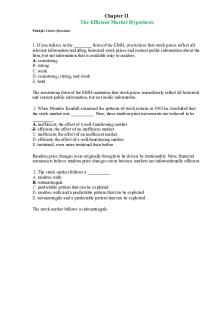THE Internal Market PDF

| Title | THE Internal Market |
|---|---|
| Course | EU Law |
| Institution | Lancaster University |
| Pages | 1 |
| File Size | 76.8 KB |
| File Type | |
| Total Downloads | 113 |
| Total Views | 242 |
Summary
THE INTERNAL MARKETPrinciple – A rticle 3 of the TEU : “the Union shall establish an internal market” Article 26(2) TFEU : “ The internal market shall comprise an area without internal frontiers in which the free movement of goods, persons, services and capital is ensured in accordance with the pro...
Description
THE INTERNAL MARKET Principle – Article 3 of the TEU: “the Union shall establish an internal market”
Article 26(2) TFEU: “The internal market shall comprise an area without internal frontiers in which the free movement of goods, persons, services and capital is ensured in accordance with the provisions of the Treaties” The Internal Market was formerly known as the common market & then the single market & its main components are: o CUSTOMS UNION – article 30 TFEU: “Customs duties on imports and exports and charges having equivalent effect shall be prohibited between Member States. This prohibition shall also apply to customs duties of a fiscal nature” o COMMON COMMERCIAL POLICY - the Members of the EU represent themselves as a single entity in trade negotiations with the rest of the world. Within the WTO the EU appears as a single trading bloc negotiating with other nations o COMMON MARKET The Four Freedoms o Free movement of goods o Free movement of persons o Freedom of establishment and the provision of services o Free movement of capital
Key Cases
SCHUL 1982: “the concept of a common market is defined by the Court in a consistent line of
decisions involves the elimination of all obstacles to intra-Community trade in order to merge the national markets into a single market bringing about conditions as close as possible to those of a genuine internal market’.”
Positive and Negative Harmonisation
Positive Harmonisation - where the EU adopts measures in an area to ensure that all MS are applying the same rules (articles 114&115 of the TFEU) o Maximum Harmonisation: where the EU adopts a measure (often a directive) which national law may not exceed the terms of the legislation. This is the default harmonisation o Minimum Harmonisation - where the EU adopts a measure setting out a threshold which national legislation must meet. National law must exceed the minimum Negative Harmonisation - where national rules are not applied as they are contrary to EU law, so they are removed (Article 28-37 of the TFEU) o Article 34 TFEU: “Quantitative restrictions on imports and all measures having equivalent effect shall be prohibited between Member States.” o Article 35 TFEU: “Quantitative restrictions on exports, and all measures having equivalent effect, shall be prohibited between Member States.” o Article 36 TFEU: “The provisions of Articles 34 and 35 shall not preclude prohibitions or restrictions on imports, exports or goods in transit justified on grounds of public morality, public policy or public security; the protection of health and life of humans, animals or plants; the protection of national treasures possessing artistic, historic or archaeological value; or the protection of industrial and commercial property...”
Quantitative Restrictions – these are quotas on goods. They are a protective measure for domestic products against foreign competition, but they are not permitted within the EU...
Similar Free PDFs

THE Internal Market
- 1 Pages

THE MARKET AND ENVIRONMENT
- 8 Pages

The Market Maker\'s Matrix
- 72 Pages

THE Kenyan Money Market
- 5 Pages

THE P2P Lending Market
- 4 Pages

The Stock Market, Explained
- 4 Pages

Chapter 9 Evaluating the Market
- 9 Pages

BTMM The Market Maker Method
- 84 Pages

How to define the market
- 3 Pages

Chapter 3 - The Goods Market
- 4 Pages

BTMM The Market Maker Method
- 84 Pages

THE Nature OF Labour Market
- 2 Pages

Ch11 The Efficient Market Hypothesis
- 23 Pages
Popular Institutions
- Tinajero National High School - Annex
- Politeknik Caltex Riau
- Yokohama City University
- SGT University
- University of Al-Qadisiyah
- Divine Word College of Vigan
- Techniek College Rotterdam
- Universidade de Santiago
- Universiti Teknologi MARA Cawangan Johor Kampus Pasir Gudang
- Poltekkes Kemenkes Yogyakarta
- Baguio City National High School
- Colegio san marcos
- preparatoria uno
- Centro de Bachillerato Tecnológico Industrial y de Servicios No. 107
- Dalian Maritime University
- Quang Trung Secondary School
- Colegio Tecnológico en Informática
- Corporación Regional de Educación Superior
- Grupo CEDVA
- Dar Al Uloom University
- Centro de Estudios Preuniversitarios de la Universidad Nacional de Ingeniería
- 上智大学
- Aakash International School, Nuna Majara
- San Felipe Neri Catholic School
- Kang Chiao International School - New Taipei City
- Misamis Occidental National High School
- Institución Educativa Escuela Normal Juan Ladrilleros
- Kolehiyo ng Pantukan
- Batanes State College
- Instituto Continental
- Sekolah Menengah Kejuruan Kesehatan Kaltara (Tarakan)
- Colegio de La Inmaculada Concepcion - Cebu


